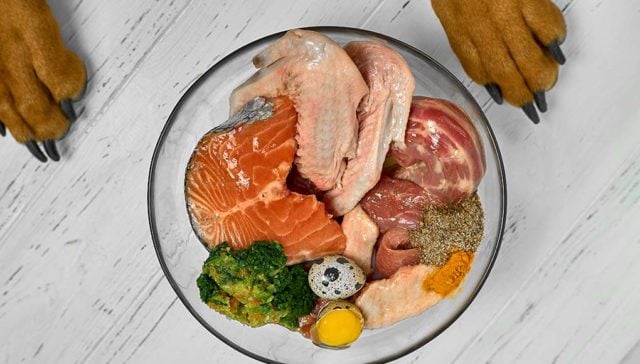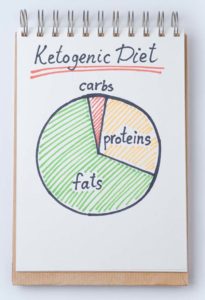
Table of Contents
In a recent survey, a large percentage of American dog owners reported that they tend to feed their pets a similar diet as they themselves follow – be it Paleo, vegan, vegetarian, pescatarian, gluten-free, etc. – and this had many veterinarians on edge.
Why? Because dogs process food differently than we do, they negatively respond to many basic food items that are even typical in the human diet (chocolate, grapes, onions), and they require a high-protein diet in order to be healthy. All facts that blatantly illustrate that what may work for the human may not work for the hound.
This brings us to one of the more popular dietary trends – the ketogenic diet (or Keto). A keto diet for dogs would be slightly different than that for people, but in general, keto is only “bad” for your pup if it isn’t properly administered, adjusted, or introduced. As with any changes to a dog’s diet, it's crucial to first consult with a veterinarian or canine nutritionist and keep the introduction process slow and steady. Be open-minded when it comes to “bending the rules” of keto or adjusting certain meals to better suit your dog.
Some owners may feel a sense of companionship when giving their pet the same diet they’re currently trying. However, it’s essential that owners understand that while strictly following the keto practice is important for their viewed version of success (whether it’s to lose weight or be healthier), their dog’s portions or meal items may differ from their own in order to reach their individual success (whether it’s to help with seizures or support an active canine lifestyle).
If you’re considering changing your dog’s diet to match the latest diet fad – Keto – then here’s everything you need to know. The keto diet can be appropriate for dogs if:
1) the change in diet is discussed with and approved by a veterinarian,
2) the correct (for the dog) ratios are used,
3) you continue to observe the pet’s physical, behavioral responses to these changes.
This article will discuss what ketosis is, how it works within the canine body, how you can incorporate the keto diet for dogs, and the benefits of low-carb, high-fat meals for your pooch.
Basics of the Ketogenic Diet
Although it’s often complicated with a rigorous schedule and exact portion measurements, the keto regime is, very simply, a menu of high fat, extremely low carbohydrates, and moderate protein.
Americans have seen this low-carb trend for a while now, although it has changed and morphed, shedding its previous names of “Atkins” or “Paleo”. Here are some of the basics of the ketogenic diet, what it entails, and how it’s supposed to work.
What’s with the name?
You’ve been hearing and seeing it everywhere, and now even dog-mom bloggers and licensed veterinarians are singing its praises. Keto is short for ketogenic. Ketones, by-products of fat-burning that naturally occur and are produced by the liver during metabolic processes, are essential for the success of the keto meal plan. Even though its true name is the “Ketogenic Diet,” society has come to simply call it Keto.
How does it work?
Keto’s main goal is to reach ketosis, a metabolic state in which the body becomes proficient in burning rich fats, i.e., adipose tissue, to energize itself instead of the “typical” fuel source – glucose (which is converted from carbs). As a result, weight loss is a common effect of the keto diet as the body switches into the constant “fat-burning mode.”
How do I know it’s working?
Since the goal of keto is to properly place its consumer in the state of ketosis, you need to monitor your pet’s progress by using a device that analyzes levels of ketones and glucose in the blood. Ketone meters and glucose strips are common options and won’t set you back too much financially.
A typical measuring device like this one will cost around $10-20, with more advanced utensils costing $50. However, this equipment is not necessary, especially for a dog owner who is mostly focused on giving their dog healthier meals with little carbs and high fat rather than rigidly following a doctor-recommended diet plan as some pets with serious health conditions may have.
What are some of the common meals consistent with the keto plan?
Since the emphasis is on consuming fats, some trending keto options among people are putting butter in your morning coffee instead of sugar, foregoing the toast of avocado toast and instead having it with scrambled eggs as well, and making nuts and coconut oil a consistent addition to snacks and meals. All of this is to avoid carbs and add more fats.
While you should not give your dog coffee or copious amounts of butter, there are canine-friendly keto meals that are popular, which include anything with vegetables that are low in carbohydrates, such as kale or spinach. You may also choose to add vegetables that have some basis of carbohydrates in them to keep the diet complex and balanced, and these would include green beans, broccoli, and/or cabbage. Here's an example of a homemade keto recipe you can try:
The key to keto diet for dogs is to include fat-rich oils such as olive oil, coconut oil, hemp oil, and/or fish oil, as well as fatty meats and fatty fish. Note that some of oils can be expensive, but there are multiple dog-centric supplements that may be cheaper that can be administered like a daily treat or broken up and added to the food bowl.
Why do I keep seeing raw meat in common keto recipes for dogs?
Dogs don’t naturally produce enzymes to break down carbohydrates, which is why many may choose the keto diet. However, you don’t have to remain rigid in order for your dog to enjoy a healthier, low-carb diet.
Because Keto emphasizes the consumption of more fats and due to the popularity of raw diets for dogs, it has led many dog owners and some animal professionals to highly recommend introducing raw meat to the canine keto plan. Meat, when uncooked, is higher in fat content so it helps keep this protein-rich and fat-rich food source that much more keto-friendly. If your dog has never consumed raw meat, please consult your veterinarian and, upon their approval, introduce raw foods to your dog properly and slowly.
Potential Benefits of Keto for Dogs
In recent years, the modern pet owner has become much more discriminatory when it comes to selecting the best food brands for their pups. People are beginning to realize how much stock there is to the popular phrase “You are what you eat,” and they’re applying it to what and how they feed their pets.
When appropriately utilizing keto diet for dogs, our domesticated pets will succeed in effectively burning fat for energy instead of converting glucose, a product popularly found in most marketed kibble (grains = carbs), into stored fat within the body. There have been studies showing how athletic dogs are better on high fat diet instead of high carb diet. But the benefits of keto for canines may be more than just keeping them in their correct weight class; for some, it could be the key to cancer prevention
Depletion and prevention of cancer cells
Canine patients with tumors have had success in improving their health, with some even overcoming the tumor completely, while on a ketogenic diet. More and more veterinarians and animal nutritionists are beginning to understand that foods not only serve as energy to the body but also to kill off cancer cells.
While glucose doesn’t necessarily quicken the production of cancerous growth, it does feed it. This is why keto for canines has been deemed a successful treatment for dogs with cancer: reducing their carbohydrate intake lessens the glucose in their blood, effectively “starving” cancer cells.
Additionally, cancers like to dine on sugar, first and foremost, but it will also sustain itself on acids found in protein, which is another reason why the fat-emphasized (with only moderate protein amounts) plan of keto may be successful for a pet with cancer.
Mitigation of seizures (epilepsy)
The origins of this modified meal plan started in the early 20th century with helping seizure-prone and epileptic children minimize, and in some cases (10-15%, in fact) completely overcome their seizure episodes.
Studies with epileptic canines found similar success rates when processed into a ketogenic diet, with roughly 30% of the dog participants greatly reducing the frequency of their seizure episodes when placed on a keto-similar diet.
Another study found that ketogenic diet in dogs with idiopathic epilepsy may help with hyperactive, ADHD-like behavior.
Is the Keto Diet Right for Your Dog?
Your dog should NOT be put on a keto if they are:
- Diabetic
You should not adjust lower doses of insulin for your diabetic pet based on the low-sugar requirements of the ketogenic diet. Always consult a veterinarian before choosing to change your dog’s treatment.
- Very young or very old
Keto is not for puppies or senior dogs. Senior dogs are likely to experience a variety of health problems, and while there are studies showing that keto diet may help with arthritis and inflammation of the joints, an old dog will need a more specialized diet plan as recommended by your vet, which is likely to contain some carbohydrates.
Young, growing pups need glucose and protein to help with the growth of healthy, strong bones. Young pups are especially dependent on the rich sugars found in their mother’s milk. Two to four weeks after weaning off the teat, a puppy may begin to eat a keto diet when approved by their veterinarian. During their stage of processing from their mother’s milk to solid foods, pay attention to the solidity and color of their waste. The stool should be solid and healthy, and any changes should be reported to a veterinarian.
What ratio is right for my dog?
The best ratio for dogs when it comes to keto is 1:1.
This ratio represents your pet’s bowl. Envision the plate or bowl you feed your dog from, now envision half of it filled with healthy fats and the other half filled with mostly protein and some vegetables – that’s the 1:1 ratio.
While this is the simplest form of understanding keto for canines, you can gradually make their meal plans more complex by playing with the ratio levels. For instance, dogs with cancer or suffering from epilepsy may have a higher fat ratio, such as 3:1 or 4:1. However, this is not a recommended ratio for your dog if they are average and healthy.
 In conclusion, unlike for people, a keto diet for dogs will be different than that for humans. Your pup doesn't necessarily need to reach the state of ketosis, and the primary concern is simply to keep carbs to a minimum, increase the amount of fats in the diet, and stick to moderate protein.
In conclusion, unlike for people, a keto diet for dogs will be different than that for humans. Your pup doesn't necessarily need to reach the state of ketosis, and the primary concern is simply to keep carbs to a minimum, increase the amount of fats in the diet, and stick to moderate protein.
Always discuss the changes in your dog's diet with a vet or canine nutritionist, especially if your pooch is taking medications or dealing with any health problems.
READ NEXT: Epileptic Seizures in Dogs – Symptoms and Treatments













